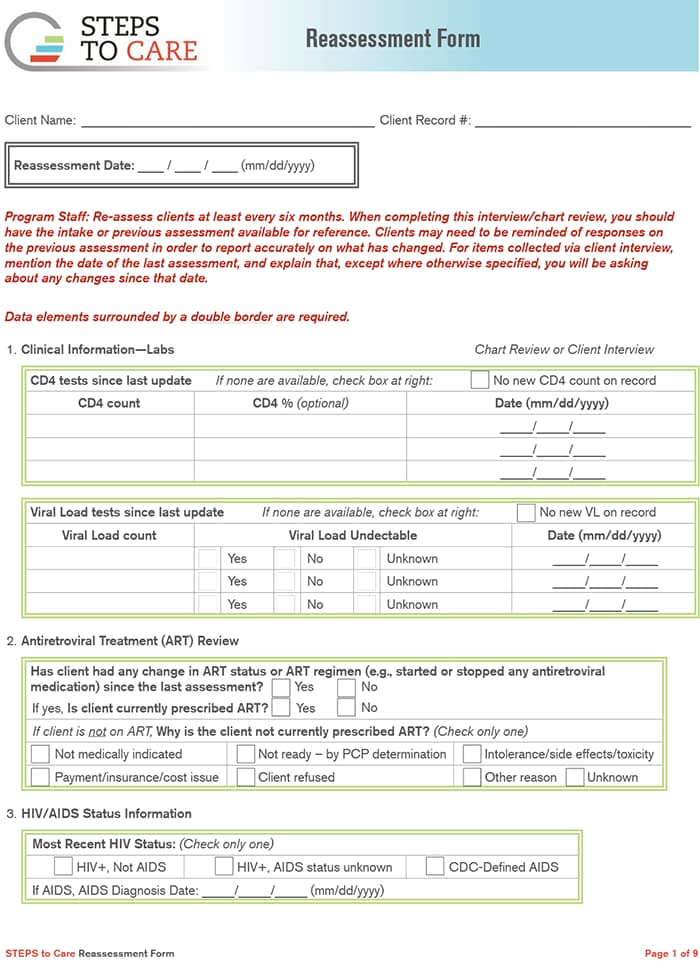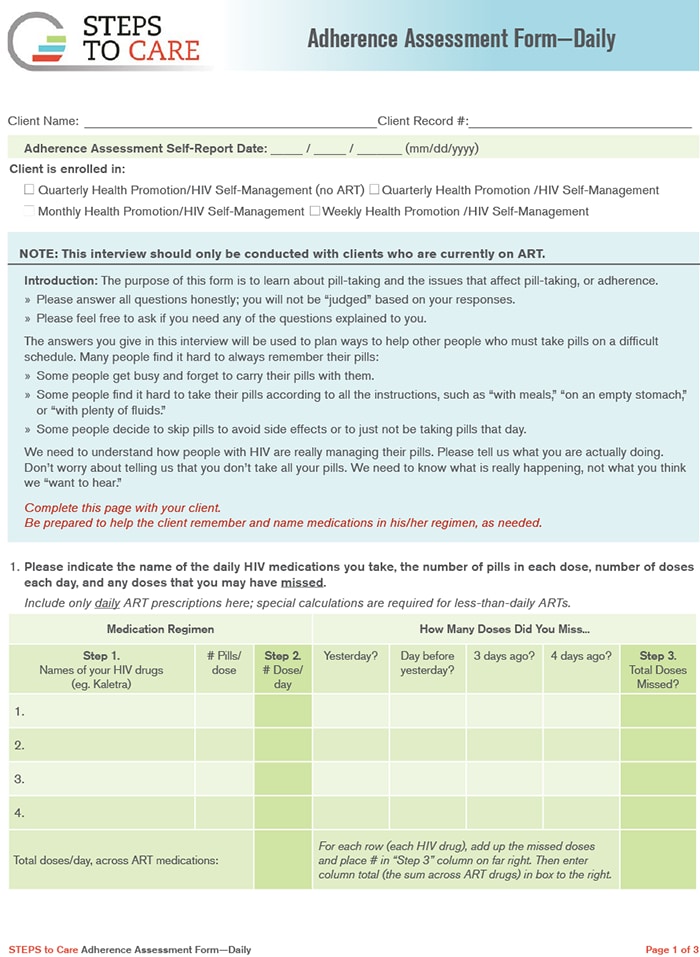STEPS to Care: Patient Navigation
Patient navigation is a STEPS strategy that provides whole-patient care through intensive case management. Patient Navigators work one-on-one with clients to encourage continued commitment and adherence to medical treatment, access to social services, improved communication, and prompt re-engagement in care.
After reviewing the information and resources below, you will know:
- The purpose and elements of patient navigation meetings
- How Patient Navigators can help clients access necessary services
- Which forms are needed to track patient navigation activities and how to complete them
Patient Navigation Meetings
Below are important elements of patient navigation meetings that help develop a comprehensive understanding of clients and their needs.
Frequency
The recommended frequency of patient navigation meetings is indicated on the client’s Care Plan. Clients can be put on a weekly, monthly, or quarterly track. Upon intake into the STEPS program, clients are typically put on the weekly track and, when deemed clinically and medically appropriate, then put on less frequent tracks as they progress through the program. STEPS staff should use Care Team meetings as a time to discuss whether the client’s current frequency is optimal for his or her needs and care.
Field and Home Visits
The close relationship fostered during field visits and regular assessments helps Patient Navigators identify and address issues in a client’s medication adherence, health status, or social environment. Conducting field visits brings care directly to the clients in settings in which they feel the most comfortable. These face-to-face meetings are used to:
- Check in with the client
- Answer any questions he or she may have
- Deliver HIV Self-Management sessions
- Provide individualized support and care to clients
Meeting times and locations are established during the intake process through the Logistics for Patient Navigation Form [PDF – 247 KB]. Regular one-on-one meetings at the client’s home or a pre-established meeting place, such as a café or library, should be carried out and documented consistently by the Patient Navigators and Care Coordinators.
Visit the Working with Clients in the Field topic page to learn more about important guidelines and precautions for field visits.
Visit the HIV Self-Management topic page to learn more about delivering health education to clients.

Reassessment Form
Reassessment (updating a client’s clinical status or social issues) should occur periodically throughout the patient’s enrollment in STEPS, especially when there has been a significant change in health status or social issues. This can include a new medical diagnosis or a change in an employment or housing situation. Information should be captured on a Reassessment Form. Any updates to client information that was originally logged in the Intake Assessment Form [PDF – 506 KB] should also be recorded here. This form should be updated by the Care Coordinator or Patient Navigator whenever needed and at least once every six months.

Adherence Assessment Form
The Adherence Assessment Form is used to document a client’s self-reported medication adherence. The type of form completed should be based on the type of medication the client is prescribed (daily or non-daily). The adherence form should be completed within the first two weeks after client intake to establish a baseline measurement of his or her adherence and should be updated once every three months by a Care Coordinator or Patient Navigator. This form can also be used as a conversation tool for conversations with clients who are struggling with medication adherence issues.
Service Coordination and Tracking
Increasing the client’s knowledge of where, when, and how to access health and related services ensures the client is receiving the best possible care and support. The Program Director is responsible for establishing partnerships with service providers that your STEPS clients may need and providing a list of these providers to Care Coordinators and Patient Navigators. These services may include:
| Services | Description |
|---|---|
| Medical Care | Includes primary care, specialty care, imaging/diagnostic service, laboratory services, and mental health and substance abuse care. |
| Housing/Benefits/Public Assistance | Includes disability rent/homeowner exemptions, senior citizen exemptions, veterans’ exemptions, and housing assistance. |
| Financial Assistance Programs | Includes tax credit and home energy assistance programs. |
| Health Insurance | Includes child and family health insurance, Medicaid, and prenatal care. |
| Food Assistance Programs | Includes food stamps; school lunch; and women, infants, and children (WIC) program. |
| Transportation | Helps clients with disabilities to access local transportation services. Care Coordinators should assist clients with applying for assessment by a health care professional to determine eligibility. If clients can take public transportation (bus and subway) or car services, work with the appropriate local services for discounts. |
| Childcare/Eldercare and Family Services | STEPS staff should not provide childcare, but instead link clients to appropriate childcare services. Program Directors should check with local and state regulations on childcare services. These services can be provided by an external provider or daycare services that may be provided at your facility. Family services include childcare, pre-kindergarten, daycare, and/or out-of-school time. |
Note that the client must provide consent before the agency releases the client’s HIV-related information to any service provider.
Services Tracking Log
The Services Tracking Log should be completed whenever a service is provided to a patient. This form should be used to track the type of service and the staff member who arranged the service. Any services that are not listed in the form can be documented in the notes section. The STEPS staff member who initiated the service (the Care Coordinator or the Patient Navigator) is responsible for updating the form. Once updated, the form should be shared between all members of the Care Team.
Medical Appointment and Care Support
Clients can have difficulty keeping track of and attending their medical appointments. In addition, they may find medical appointments intimidating or difficult to understand. Patient navigation addresses these and other obstacles that clients face in attending medical appointments and understanding the care being provided to them by:
| Care support | Description |
|---|---|
| Assistance | Link clients to services to address potential barriers to medical appointment attendance, such as transportation (public transportation, taxi voucher, or a ride in a program-leased car), childcare services (not by a STEPS staff member), and language interpretation. See the Service Coordination and Tracking section of this page for more information. |
| Physical Accompaniment | Accompaniment to routine primary care appointments, and other appointments, such as housing assistance, when necessary. Assist with medical and social service appointments. |
| Scheduling Assistance | Assist with medical and social service appointments. |
| Reminders | Remind clients of upcoming appointments during in-person meetings and via phone (at minimum, 3 days before and the day of the appointment). |
| Documentation | Document client appointments to ensure missed appointments are followed up on. See the Establishing Policies and Protocols topic page for more information. |
| Care Plan Review | Review at the conclusion of every primary care visit. Planned patient navigation activities should be documented in the Care Plan Form. See the Care Plans topic page for more information. |
| Translation of Medical Terms of Concepts | Translate into more accessible language for the client. |
Referrals/Appointments Tracking Log/Checklist
The Referrals/Appointment Tracking Log/Checklist is used to track the services and resources a client needs to attend internal and external medical appointments. The Patient Navigator and Care Coordinator should document the services provided (transportation, accompaniment, childcare, etc.) and whether the appointment was completed, rescheduled, or missed.
This form can be used to delegate and track service referrals between STEPS staff and as a “checklist” of services to provide, if needed, to the client before an appointment to ensure they can attend it. It can also serve as a valuable tool for communication regarding clients’ specific needs during Care Team meetings. To learn more about tracking individual Patient Navigator schedules, view the Scheduling Client Meetings topic page.
Referrals/Appointments Tracking Log/Checklist [PDF – 190 KB]



